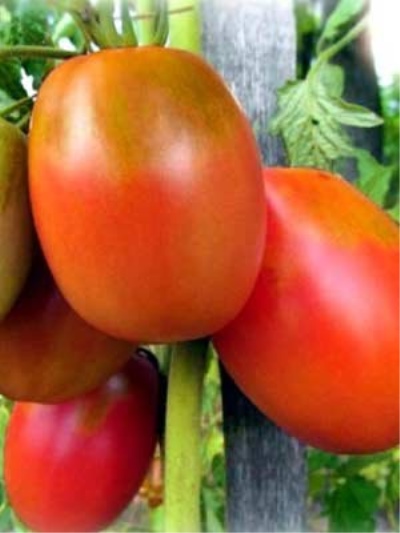
- Authors: Botyaeva, G.V., Dederko V.N.
- Year of approval: 2007
- Category: grade
- Growth type: determinant
- Appointment: fresh consumption
- Ripening period: early
- Ripening time, days: 100-110
- Growing conditions: for open ground, for film greenhouses
- Transportability: Yes
- Bush size: undersized
Tomato Altayechka belongs to early determinant varieties. Since 2007, it has been actively cultivated in the summer cottages of gardeners from all parts of the country. Full of vitamins and nutrients, the variety is mostly eaten straight from the garden.
Description of the variety
The authorship of the breeding of Altaechka belongs to GV Botyaeva and VN Dederko. Thanks to their work, it was possible to obtain undersized compact bushes 70-90 centimeters high. Standard bushes are covered with dark green leaves of moderate size.
The main qualities of the fruit
Formed, but not yet ready to harvest, the fruits have the standard green color for unripe tomatoes. Over time, it changes to a spectacular crimson. Egg-shaped fruits with ribbing weigh, as a rule, about 124 grams, but this is far from the final figure. The dense pulp is hidden by a thin skin. Each fruit has 4 to 6 chambers inside.
Taste characteristics
Altayachka tomatoes have a simple but rich taste. It can rightfully be called a classic tomato.
Ripening and fruiting
Harvesting of tomatoes of the described variety begins 100-110 days after planting. This allows Altaichka to be ranked among the early varieties. Starter harvests are already available in the first half of summer.
Yield
Altayechka is assessed as a high-yielding variety of tomatoes. About 8 kg of tomatoes are usually harvested from a square meter, but this number can be increased.
The timing of planting seedlings and planting in the ground
Summer residents recommend growing this variety by the seed method. Seeds are sown 55-60 days before the planned planting in open ground. Most often, in terms of time, this is the end of February or the beginning of March, depending on the region. For successful cultivation, you will need fertile soil, where the seeds are located at a distance of 6 cm from each other. They are slightly pressed down, and then covered with earth. Immediately after planting, the soil is watered with warm water and covered with a shelter.
In the room where the seedlings grow, it should be warm - about +25 degrees. The first days the sprouts are watered, always in the evening. Spraying method is recommended. As soon as foliage begins to form, a pick will be needed. At the age of two weeks, it is recommended to feed the seedlings of this variety with special fertilizers intended for tomatoes. Top dressing is repeated after another 2 weeks. Hardening is required. In May, most summer residents can transfer seedlings to a permanent place of residence.

Growing tomato seedlings is an extremely important process, because it largely depends on whether the gardener can harvest at all. All aspects must be taken into account, from seedbed preparation to planting in the ground.
Landing scheme
In order for each plant to have enough nutrients from the soil, it is recommended to plant no more than 3-4 copies per 1 square meter. The distance between the individual shoots will be 50 cm.It is worth leaving a passage 40 cm wide between the rows.

Growing and care
Altaichka is distinguished by unpretentious care. The plant does not need to be formed and tied due to the compactness of the bushes.
But watering will need to be carried out regularly. Rainwater works best. Watering is recommended early in the morning or in the evening, avoiding the ingress of liquid on the foliage. A bush usually takes about 5 liters, which is enough for watering once a week. When the tomatoes start to turn red, you need to stop watering them, otherwise they may crack. If the plants grow in greenhouses, leave the door open for a while after watering to allow fresh air to flow.
Experienced summer residents advise using rotted sawdust mulch for this variety. It retains water in the soil and allows plants to receive more sun. As a result, the crop grows about 7 days earlier, and there is always more of it.
Altaichka also needs additional feeding. They will be standard, as for other types of tomatoes, but there is still one trick here. This is an infusion of ash, thanks to which the fruits will turn out to be more juicy and sweeter. Take 2 cups of this ingredient and pour 10 liters of warm water. The infusion should stand for about 5 hours. Then they can spill the plants every 2 weeks.




A plant needs different micronutrients at each stage of growth. All fertilizers can be divided into two groups: mineral and organic. Folk remedies are often used: iodine, yeast, bird droppings, eggshells.
It is important to observe the rate and period of feeding. This also applies to folk remedies and organic fertilizers.
Disease and pest resistance
The variety as a whole is very rarely sick. If the proper conditions are provided, and the greenhouses are regularly ventilated, then diseases will be bypassed. Preventive treatments are required. They are treated with both folk remedies and fungicides.
The main advantage of Altayachka is that it ripens before late blight can develop on it. And this disease has already ruined many crops.


Review overview
Reviews about Altaychka are mostly positive. Gardeners claim that the fruits are very tasty, and many ate them before they even had time to canning. Despite the fact that the declared weight of the tomato is 124 grams, some summer residents managed to grow real giants of 500 grams each.
However, not everyone succeeded in achieving such amazing results. So, certain gardeners said that there were few fruits on the bush, and the harvest was weak.

























































































